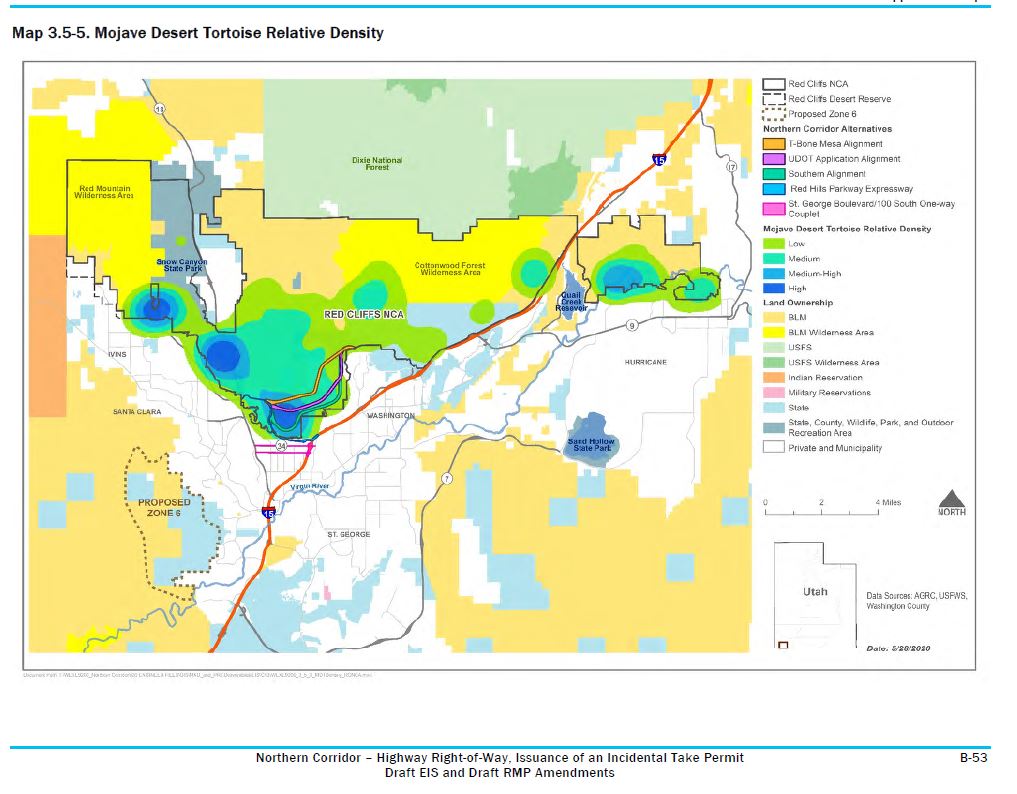9. BLM must pause the environmental review for the Northern Corridor Highway to issue a supplemental study of the impacts of recent devastating wildfires in Red Cliffs.
What the DEIS does or doesn’t say:
- Within Red Cliffs, tortoise surveys between 1999 and 2020 show an overall decline of 41 percent due to drought and wildfire.[1]
- The number of tortoises in Zone 3 declined by 31% between 2017 and 2019[2], suggesting that this population is already under stress.
- 2005 wildfires burned approximately 11,500 acres in Red Cliffs, killing 15% of the desert tortoise population in Zone 3.[3] It is reasonable to anticipate that recent fires may cause a mortality rate in desert tortoise of 15% or more.
- Since 1976, 22 fires have burned 15,913 acres inside Red Cliffs with over 3,808 acres burning multiple times. Recent localized analysis suggests high fire danger days are likely to increase.[4]
- Mojave Desert species are not adapted to the current pattern of frequent large-scale wildfires, and do not recover quickly or successfully from the effects of fires. Fires hasten the conversion of native desert shrublands to invasive grasslands, fueling a devastating burn-reburn cycle.[5]
The Problem:
- The Turkey Farm Road and Cottonwood Trail Fires have burned approximately 14,000 acres (20%) of Red Cliffs Zone 3 – an area home to the largest population of threatened Mojave desert tortoise in the Reserve.
- The proposed NCH is routed through Zone 3, and the Turkey Farm Road Fire came within ¼ mile of the BLM-preferred alternative for the highway.
- The NCH would increase the risk for future catastrophic wildfires in Red Cliffs caused by vehicle collisions, dragging tow chains, tire blow outs, tossed cigarette butts, fireworks, and conversion of native vegetation communities to invasive grasslands. (See map below).
- The fires most likely traveled through low, medium and perhaps high-density tortoise habitat. (See map below).
- Conditions in Red Cliffs have changed dramatically, and the current DEIS is no longer adequate for calculating the impacts of the NCH. (See pictures below).
Commenting Guidance:
- BLM must pause preparation of the environmental analysis and review of the proposed NCH under the National Environmental Policy Act, the Federal Land Policy and Management Act, and the Omnibus Public Land Management Act of 2009.
- After the full ecological impacts of recent fires are examined and assessed, BLM must issue a supplemental DEIS.
- Council on Environmental Quality regulation 40 CFR 1502.9(c)(1)(ii) requires an agency to supplement a DEIS when there are “significant new circumstances or information relevant to environmental concerns and bearing on the proposed action or its impacts.”[6]
- Recent wildfires have burned over 20% of the land in Red Cliffs. The DEIS’s disclosure of previous wildfire impacts in Red Cliffs in no way accounts for the current damage.
Use elements of the “problem” statements to bolster your points.
Add a personal note:
- Did you witness the 2005 wildfire season in Red Cliffs? If so, what changes have you noticed following the fires?
- Have you volunteered for habitat restoration work in Red Cliffs to plant native vegetation in burned areas? What has this experience taught you about the rate of rehabilitation in the Mojave Desert? (Note that the Turkey Farm Road Fire burned some of the habitat restoration plots).
- Are you worried that the NCH could increase the risk of catastrophic wildfire in the future? Explain why.
[2] DEIS Volume 2, page 3-48. Table 3.5-3. Approximate Mojave Desert Tortoise Population and Density Estimates Associated with the Reserve (Zones 2, 3, and 5)
[6] https://www.govregs.com/regulations/40/1502.9
Photos of the Turkey Farm Road and Cottonwood Trail Wildfires in Red Cliffs, Zone 3
Top row: Turkey Farm Road Fire.
Bottom row: Cottonwood Trail Fire.
Turkey Farm Road Fire Map

Recent wildfires have impacted the threatened Mojave desert tortoise and a number of BLM-sensitive species. Species are listed as “sensitive” in an effort to prevent them from becoming listed as threatened or endangered in the future.





